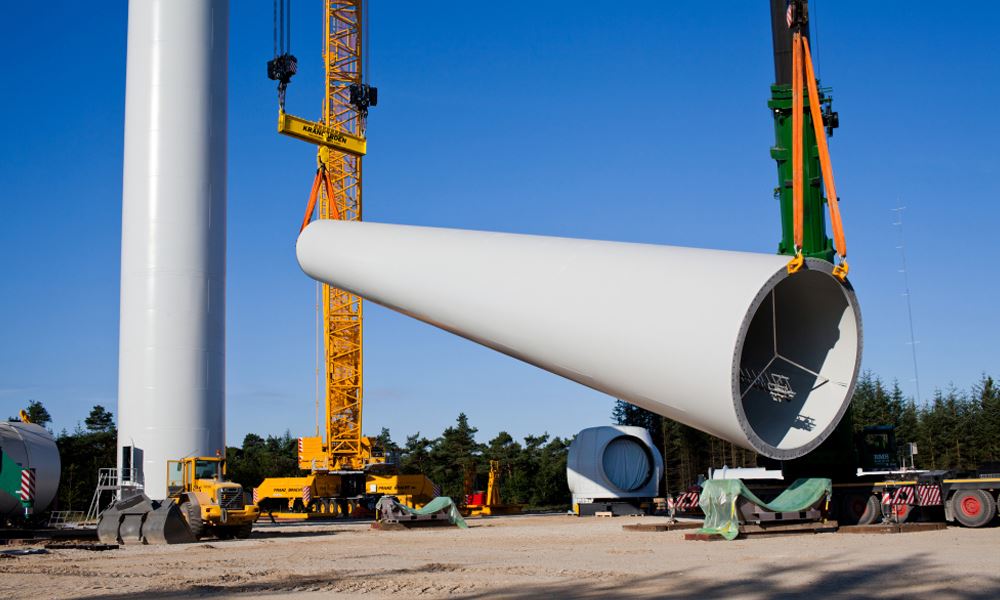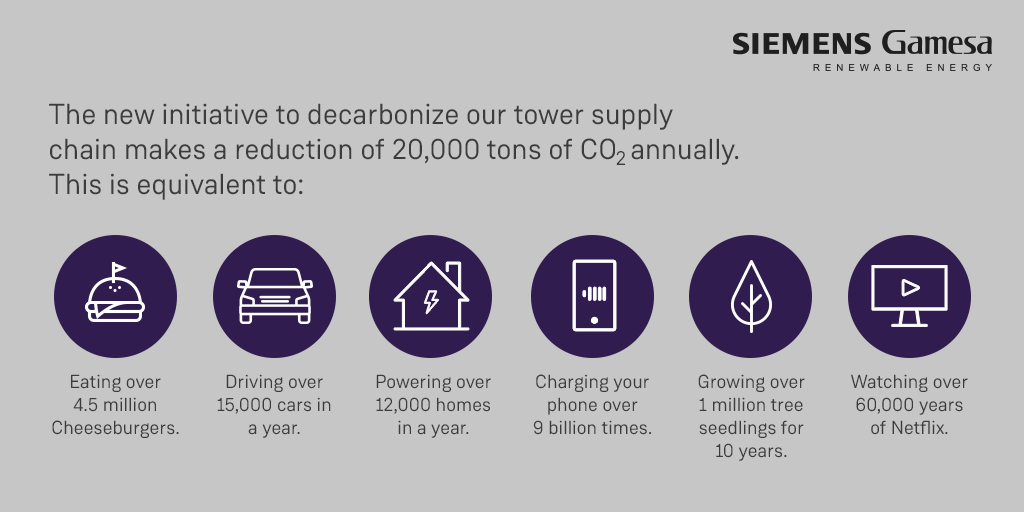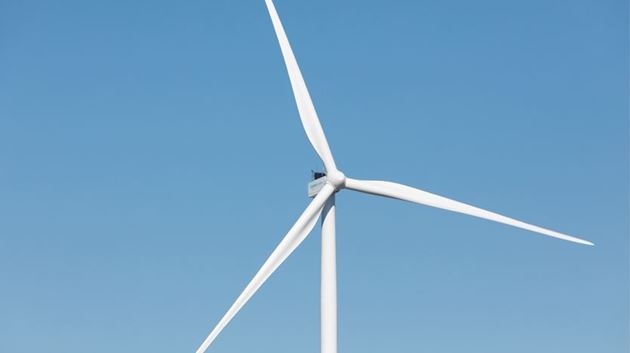Over the course of 2020?Siemens Gamesa has?recorded?several crucial decarbonization successes – becoming carbon neutral or switching to 100% electricity from renewable sources to?name just a?few.?But we?are committed to?going?further: reducing?indirect emissions in our supply chain?is a?vital?step?on?our journey?to net-zero emissions by 2050.?The production of towers is?a major source of carbon emissions worldwide?and therefore a great place to start.?Siemens Gamesa deployed?a decarbonization project for the tower supply chain?with?promising first results:?a?reduction of?20,000 tons of CO2?emissions annually,?approximately 20% of the emissions generated by its main tower suppliers. Compared with emissions derived from all our activities, this reduction accounts for more than 70% of the company’s annual emissions.
The?transition?from fossil fuels?to a low-carbon?economy is key?to?mitigating?climate change. A critical?piece of the puzzle?is?a?corporate?commitment?to achieve net-zero emissions across their operations but also in their supply chains, usually a key?bottleneck for accelerating?the?transition. Siemens Gamesa?committed to?an ambitious roadmap?early on?to achieve net-zero?emissions by 2050, which?was?verified by the Science Based Target initiative (SBTi)?this summer.?Another?important milestone?in our?decarbonization strategy?was switching to?electricity?from?100% renewable sources?worldwide?– achieved in?the?fall this year.??
But?our?ambition goes?further.?To reach our?overarching goal of becoming net-zero, reducing our?indirect emissions generated in?the?supply chain?is inevitable,?as over 80% of the carbon footprint of our wind turbines is linked to the materials used?in?their manufacturing.?To mitigate the supply chain impact,?we?are?working?with?our?suppliers and supporting?them on their own?decarbonization?journey.

Working with tower suppliers?to?significantly?reduce the carbon footprint?? Initiated by?a group of employees, the?company?has?put in place a decarbonization project?for the tower supply chain.?Steel, which is the main material used for towers,?is a major source of carbon emissions worldwide. It is also the dominant source of emissions when assessing the climate impacts of a wind turbine.?In fact,?during the process of manufacturing?CO2?emissions account?for?roughly two times?a?tower’s?weight.??
After?an initial assessment of?the CO2?emission figures,?Cresten Flor, Head of the Onshore Tower Operations team in the Northern Europe and the Middle East region, concluded that it was time to act. Together with the Procurement team, they developed the ‘Supply Chain Decarbonization Program’ that aims?to reduce?the environmental impact of the company’s tower suppliers?leading?the way to a more sustainable supply chain.
“We are?reducing the carbon footprint of?our own?production facilities and offices,?but?we know that?the main challenge?going forward will be?to?reduce emissions?in?our?entire?supply chain. The?joint?program?from Tower Operations and Procurement?aims at?consciously?reducing?CO2?emissions emitted during the manufacturing?process?of our products and the required raw materials?to have the?most sustainable?value chain,”?Cresten states.?“We?now have?full transparency of where the CO2?emissions occur and how they can be reduced. This allows?our suppliers?and us?to push for the needed change”.?
This program, launched in?early 2019,?stands on three pillars:?(i)?implementing?a?transparent?annual process to evaluate the sustainability performance?of each?supplier;?(ii)?incentivizing suppliers to join the effort in?reducing the shared environmental impact?by rewarding?good performance with?a bonus system;?(iii)?and?establishing a collaborative relationship with suppliers by providing education and guidance on sustainable practice. The program?shows promising first results.?Three?of our?main tower suppliers?have already agreed to switch to renewable energy sources. This?will reduce the relative global average carbon intensity of tower manufacturing by 25%,?entailing?an absolute reduction of about 20,000 tons of CO2?emissions annually.?If we compare this figure with?the emissions derived?from?our direct operations, it?accounts for a?72% reduction?of those emissions.?“But this is more than?a?figure,”?clarified?Cresten. “We are happy?to see real action and changes, like the installation of solar panels in?one of?our?supplier’s?factories to feed?its?operations?with clean energy”.??

And this is just the?beginning:?other suppliers are planning?to follow?the example, introducing further significant CO2?reductions.?The idea is to?expand?the?initiative to?around?40 suppliers, targeting a reduction of?100,000 t?of?CO2?in 2021. Collaboration matters?? Cresten highlights the personal aspects of this project. “For me this project is an example of a corporate culture that?allows ideas to grow and prosper.?It shows that we can make a huge difference?with?what others would consider small changes?by?simply?collaborating internally?and pushing?our external partners?to operate more sustainably. It makes me proud to see that Siemens Gamesa saw the value in?our?initiative and?that it is now being rolled out?to?the entire tower supply chain?globally.”??
Partnering with the?Procurement department proved to be the driver to bring the tangible results.?The?decarbonization?of manufacturing processes?of?Siemens Gamesa’s?suppliers is?becoming a?supplier selection?criteria. A?‘Sustainability/Greenhouse Gas Emissions’ category is incorporated into the?Towers?yearly supplier evaluation process and gives?the company’s?suppliers an opportunity to present their CO2?reduction efforts.

“We are?working to implement a sustainable procurement approach, which means that we not only focus on a cost-benefit analysis, but also?see the bigger picture of?how to maximize the benefits for both the company and society.?When we select a?tower?supplier to work with, the?decision is based on criteria that supports the decarbonization of the supply chain alongside the conventional procurement criteria of price, quality and delivery?reliability,” stated David Anderson, Head of Towers Procurement in Siemens Gamesa. He adds:?“With the transparency achieved in this initiative, we support our suppliers in tackling the most relevant and impactful items. This implies,?of course,?encouraging suppliers to innovate, change and push ideas forward to achieve our carbon emission reduction targets.”?
The promising first results of the program?have driven a global development of the initiative.?Siemens Gamesa has a clear ambition to include the supply?chain?in its decarbonization efforts?and set?targets accordingly.?“This first pilot?program?offers lessons learned that can be applied to other areas of the organization,?for sure.?We are currently expanding this for tower procurement globally, meaning increasing the number of suppliers from 10 to?about?40, and?will then?gradually expand the scope from there?across multiple high impact commodities,” says David Anderson?and adds, “Clearly, it shows how the commitment of a dedicated team?can lead to great results and accelerate our decarbonization efforts?to limit global warming to maximum 1.5°?Celsius.”?
Siemens?Gamesa still has a long way to go to reach its ambitious?decarbonization?goals but is taking firm steps?on the road to a?low-carbon?value chain.
Global Head of CSR
Lisa Marie Von Raepke



